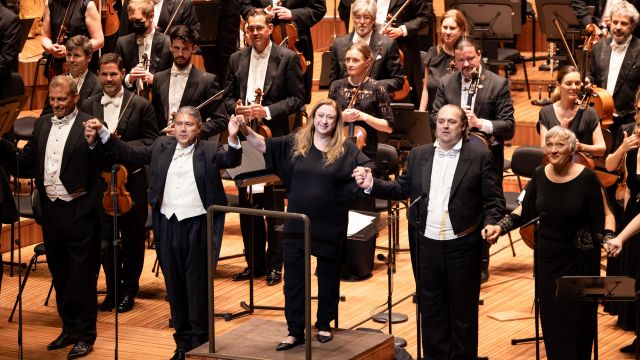Das Rheingold
Das Rheingold is the first of Richard Wagner’s four famous “music dramas” Der Ring des Nibelungen, best known as The Ring Cycle. Based on German and Norse legends, the four operas – Das Rheingold, Die Walküre, Siegfried, and Götterdämmerung – tell a story of greed and power and love, all of which begin in Das Rheingold, when the Nibelung dwarf Alberich forsakes love for power by stealing gold from the Rhine maidens. Fashioned into a magic ring, the gold grants the person in possession the power to rule the world – and all the problems that might bring.
The opera begins in the dark depths of the Rhine where the Rhinemaidens guard the Rhinegold. If the gold remains hidden at the bottom of the river, the world is in balance – but Alberich, smarting at being rejected by the Rhinemaidens, sees the gold when a shaft of light penetrates the water. Told of the power of the gold, he steals it and takes it beneath the earth to Nibelheim where he convinces his friends to make it into a magic ring and helmet.

Chief of the Gods, Wotan, and the giants Fasolt and Fafner to whom he owes money for building his citadel, Valhalla, hears of the gold and its power. Wotan and the fire god Loge descend into Nibelheim and trap Alberich, taking him back to Valhalla, and demanding the ring. Alberich curses the ring saying: “Through its gold comes immeasurable might, now let its owners find death”. Thus the drama of the Ring Cycle is foretold.
The two-hour long musical drama that is Das Rheingold is “told” by an orchestra of over a hundred musicians including four harpists, and fourteen opera artistes, who take the audience from the deep waters of the Rhine to the turrets of Valhalla, meeting the legendary dwarf and giant characters and being warned of the damage that the magic gold ring will bestow!

It’s a complex story, that Wagner tells in musical motifs and dramatic ideas that Simone Young and the orchestra relate vividly, from the cold, dark depths of the Rhine to the high spires of Valhalla. Young is a delight to watch. Her familiarity with this incredible piece of music is strong, her confidence and control amazingly clear as she brings the orchestra together, or momentarily ‘nods in’ one singer or another. It is always a joy to watch a conductor and orchestra in that special synchronicity … and Wagner requires this more than most.
Any performances of his work – especially The Ring Cycle – attracts artists from all over the world. To see and hear fourteen internationally acclaimed artists together on the stage of the Concert Hall in concert is a special privilege. To have them, Young, the SSO and Wagner is a once in a lifetime event for many those who filled the Concert Hall to sit in awe for two hours, spellbound by the music, the voices and the atmosphere of mystic myth that Wagner created.

The performance began in total dark, the “E flat low in the orchestra” trembling through the hushed Concert Hall “until a shaft of light” revealed the “gold” of the brass horns and glittering strings of the harps. It was a dramatic opening, to a performance that accentuated the drama and theatricality that is intrinsic to Wagner’s music.
Carol Wimmer
Photographer: Daniel Boud
Subscribe to our E-Newsletter, buy our latest print edition or find a Performing Arts book at Book Nook.

